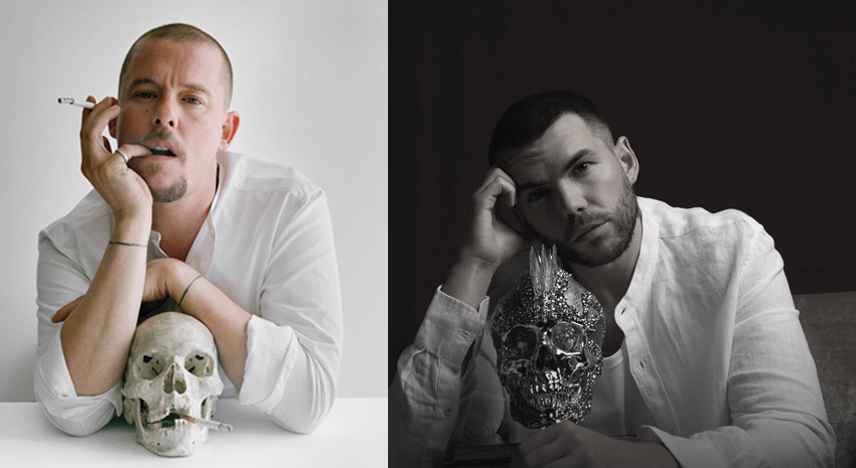By Alix Cohen
“Give me time and I’ll give you a revolution.” Alexander McQueen (1969-2010)
Though set in the world of fashion (marvelous costume and accessory design by Kaye Voyce), this might be the tragic story of any artist determined, no matter the consequences, to serve art rather than commerce. It’s illuminating and provocative.
Lee Alexander McQueen pursued his vocation like a heat seeking missile. Applying the words to design, he seemed to live by the creed of prima ballerina, Anna Pavlova: “If I can’t dance, I’d rather be dead.” Whatever you think of his oeuvre, the couturier’s story is unexpected, dramatic, and resonant.
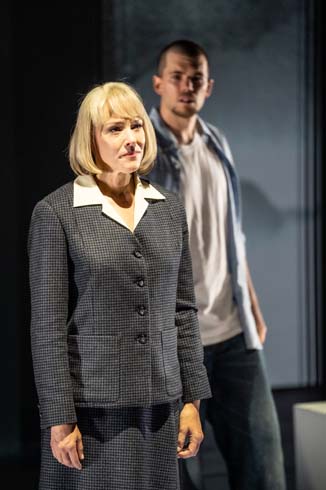
Emily Skinner (Joyce McQueen, Alexander’s mother) &
Luke Newton (Alexander McQueen)
The couturier struggled with mental illness (diagnosed with mixed anxiety and depressive disorder later in life) compounded by drug use. That he managed to exert great influence without education, background, or polish evokes Dickens.
Sweeping across a screen is text signifying research on methods of suicide. Adult McQueen (Luke Newton) is seen testing weapons. Suddenly we’re in Ibiza where the designer, desperate for connection, playacts marrying a lover he barely knows aware the young man’s motivation is financial. On the telephone, he tells adored mum Joyce he’ll see her soon.
A glimpse of childhood in London’s East End (Matthew Eby as young ‘Lee’, as his loved ones called him) introduces the boy’s dismissive father Ronald (Denis Lambert) and extremely loving and supportive mother (Emily Skinner.) Sister Janet ( entirely credible Jonina Thorsteinsdottir) was on Lee’s side, but found his fashion “ugly.” Her husband (Joe Joseph) abused Lee (not made clear in the play.) Both the future designer’s imagination and proclivity are clear from the beginning.
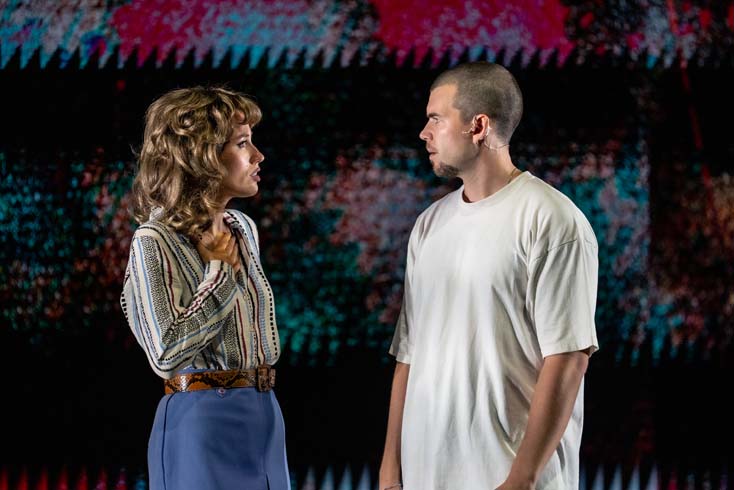
Jonina Thorsteinsdottir (Alexander’s sister Janet); Luke Newton (Alexander McQueen)
McQueen attended Central St. Martin’s College on borrowed funds. His entire ersatz, blood-splattered Jack the Ripper Stalks His Victims graduation collection, replete with his own hair sewn into labels, was purchased by fashion editor/stylist/ talent scout Isabella Bow. (Catherine LeFrere)
Next to his mother, Bow was the most important person in McQueen’s life. She had a profound and catalytic effect on his work, indefatigably promoted and encouraged him, and wore his pieces with unmatched conviction. That he never offered her a position as salaried “muse” (common with couturiers at the time) was increasingly hurtful and surely contributed to her own volatility.
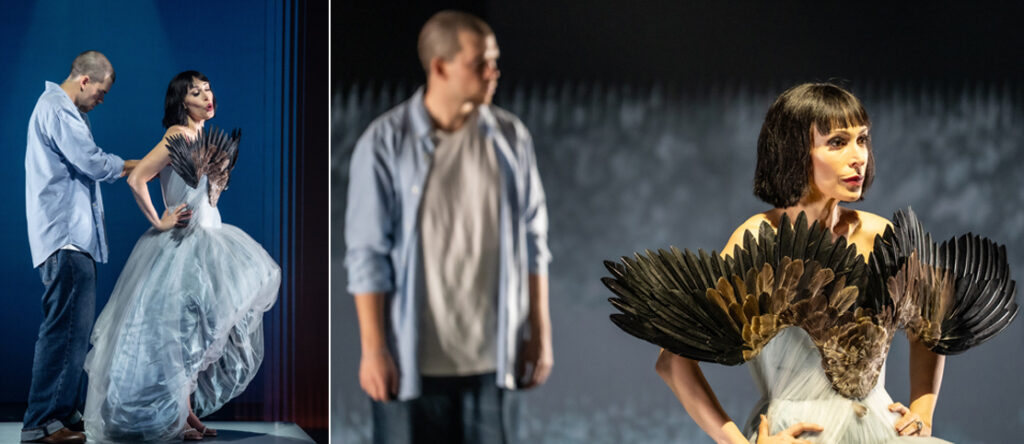
Luke Newton (Alexander McQueen) & Catherine LeFrere (Isabella Bow)
The designer apprenticed on Savile Row- where we see him beat up by established peers, worked for a theatrical costumer, talked his way into Romeo Gigli (Milan), founded Alexander McQueen (18 years; 36 collections) and, in 1996, became head of Givenchy, straddling responsibilities there with those of his own label.
Every approach to employment is portrayed as desultorily, conducted in a strong, lower class accent, wearing an old t-shirt and jeans, carrying a plastic garbage bag of samples. Why anyone hired him is a mystery. One can only presume outstanding tailoring skills held positions until the designer began to manifest his own startling vision.
We see fragments of The 1995 Highland Rape line featuring torn tartans and hear reference to 1996’s Joan of Arc which ostensibly saluted martyrdom and feminine strength. The Dante Collection was staged in a church with a human skeleton sat in the front row. “I use things that people want to hide in their heads. War, religion, sex; things we all think about, but don’t bring to the forefront.” (McQueen)
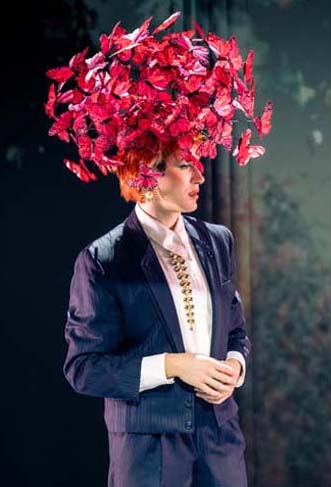
Spencer R. Petro
Models are dressed before us for several historical presentations including the last runway show, Plato’s Atlantis. These are beautifully, evocatively realized. If you’re unfamiliar with McQueen’s more extravagant designs, this offers a glimpse.
More demands create more pressure. Use of cocaine and prescription medications increase as does hooking up at discos in declared hope of ‘settling down’. Did he even believe this of himself? People fall away. McQueen spirals. He’s inattentive of those women most instrumental and valued. The piece, like his life, becomes a whirlwind.
Playwright Darrah Cloud has a good sense of the hero’s mental and emotional life. Individual scenes feature revealing dialogue. Even fleeting relationships are clearly established, though, do we need to meet so many lovers? A parenthesis of disco dissolution is too long and frankly unnecessary. Narrative pivots from adult trajectory, to childhood, to a fictional This Is Your Life tv interview pinballing from between.
One notable interview response that was actually published in The Guardian, is McQueen’s telling mum Joyce that his greatest fear is “dying before you.” The designer committed suicide at 40, the day before her funeral in 2010. Integrating that pivotal line and perhaps selected others would eliminate the need for studio interruptions.
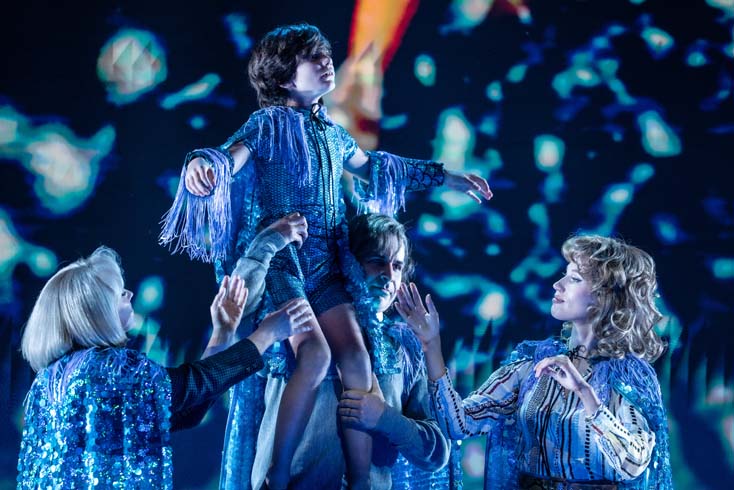
Young Lee’s dreams: Emily Skinner, Cody Braverman, Joe Joseph, Jonina Thorsteinsdottir
Both Emily Skinner and Catherine LeFrere are excellent, each actress sympathetic in her character’s own way. Skinner’s Joyce projects British after-the-war pluck and absolute devotion. LeFrere’s depiction of Bow’s battling depression and feelings of professional and personal alienation is vivid. The actress visibly exults in his fashion.
Luke Newton, known for his heartthrob turn in Bridgerton, is simply wonderful in this couldn’t-be-more-different role. He looks remarkably like the designer. Speech patterns and bearing land accurately. McQueen’s evolution from guileless aspirant, to beleaguered creator, to tortured life on a fault line is gradual; we take the journey with him.
Director Sam Helfrich conjures individual personalities during a storm of scenes and eras that might otherwise flatten. Use of the stage is aesthetic. We always know where we are. Newton and company handle ostensible couture with skill and respect. Intimacy (NJ Agwuna) is well manifest, violence artfully indicated.
The company plays multiple roles. Spencer R. Petro’s socialite fashionista and Fady Demian as McQueen’s longtime assistant Simon are familiar characters, grounded in performance.
“Beauty can come from the strangest of places, even the most disgusting of places.” (McQueen)
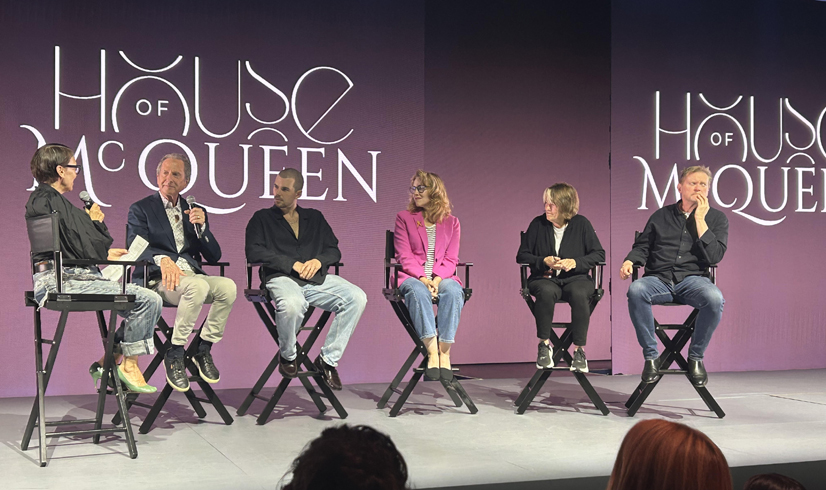
Professor Shelley Fox, Rick Lazes, Luke Newton, Emily Skinner, playwright Darrah Cloud, director Sam Helfrich
A press talkback after the play is ably lead by fashion professor Shelley Fox. “He was one of those people who made everything feel possible,” she notes. Executive Producer Rick Lazes was inspired to take on the project by Andrew Bolton’s book and the subsequent, record breaking Metropolitan Museum exhibit. “If people weren’t exhilarated or made nauseous (by his clothing), he was happy,” Lazes comments.
“How would you describe this to someone who assumes it’s just about fashion?” Fox asks director Sam Helfrich. “It IS about fashion, but his work in fashion was art… This really is a play about a person, not just a biography, but the creative process, trying to get inside someone’s head,” he answers. “Lee was analog, not digital. He got his fingers dirty. I related to that as a writer,” adds playwright Darrah Cloud. “He wore his heart on his sleeve. How do we preserve that kind of person?”
Major resources were The 2018 documentary McQueen which can be streamed on Netflix, Prime, and Apple.
And the book Alexander McQueen: Savage Beauty by Andrew Bolton, who curated the wonderful Metropolitan Museum of Art show. https://www.amazon.com/Alexander-McQueen-Savage-Andrew-Bolton/dp/0300169787
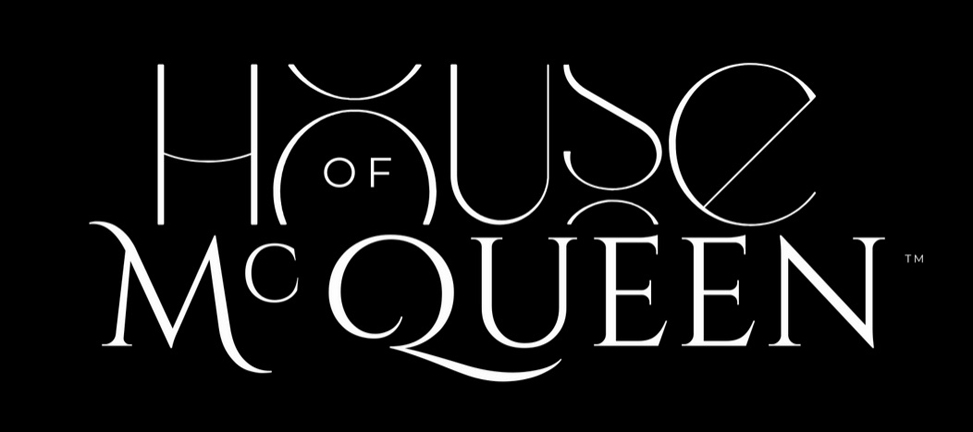
After the designer’s death, Daphne Guinness famously purchased Isabella Bow’s entire collection of McQueen preserving it as a tribute to both figures. She wore garments not just to galas and fashion events, but as part of her daily wardrobe, treating apparel as wearable art.
LED screens above and at the back of the stage show enlargements of garments, tv talking heads, and a mélange of painterly, organic visuals illustrating emotion. For the most part, these manage to act as framing rather than swallowing up actors. (Video & Projection Design- Brad Peterson)
Original Music by Andres Martin is so integral, one hardly notices its enhancement of the play.
Dialect Coach Deborah Hecht separates working class and upper class accents – a rarity.
To the left of the theater interior, a small, well mounted exhibit of McQueen’s designs should not be missed. Many of the privately collected garments from 1995-2010 have never been previously displayed. It’s possible to get quite close to pieces. Curated by Gill Linton, founder of contemporary vintage reseller, Byronesque, the room may be visited before curtain or during intermission.
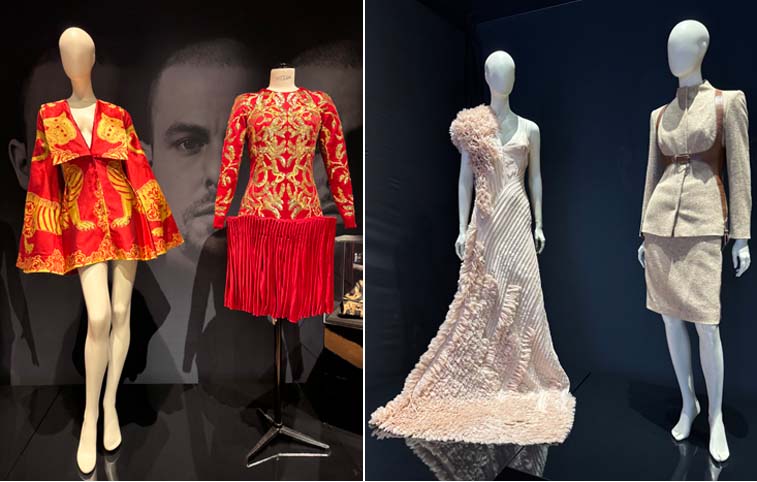
The Exhibition
The 499 seat theater was built FOR this production. It’s comfortable and deeply raked for good viewing.
Photos by Thomas Hedges
Opening: Left hand photo of Alexander McQueen by Tim Walker; Right hand photo of Luke Newton by Thomas Hedges
House of McQueen
By Darrah Cloud
Creative Director- Gary James McQueen
Based on a book by Rick Lazes & Seth Koch
Directed by Sam Helfrich
The Mansion at Hudson Yards 508 West 37th Street
https://www.thehouseofmcqueen.com/

